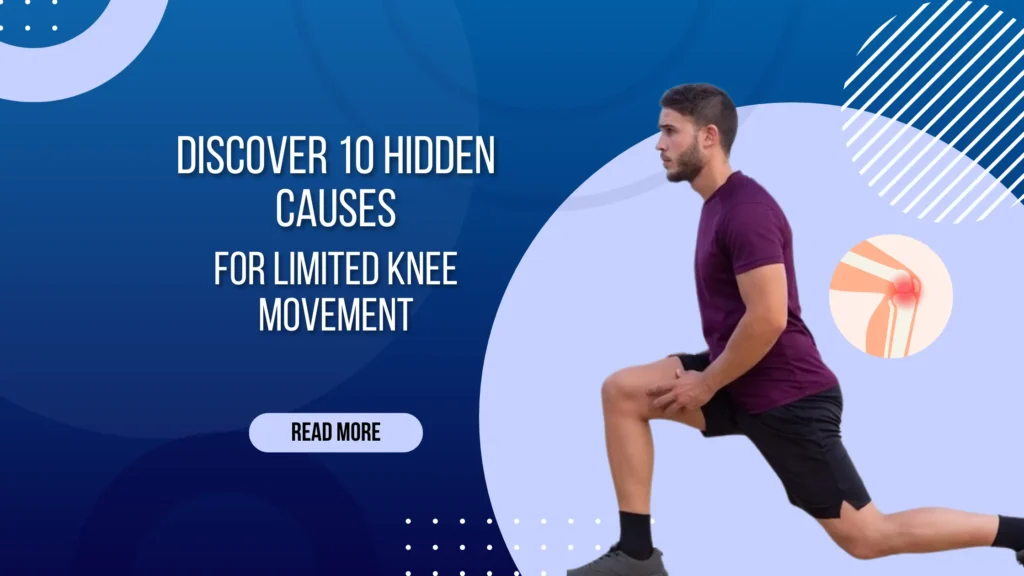Discover 10 Hidden Causes & Effective Relief with Vishudh Kaya!
Your knees are the unsung heroes of your body, silently supporting you in almost every move you make—whether it’s walking, bending, climbing stairs, or simply standing. Now, imagine a world where these everyday actions become difficult or painful. Suddenly, tasks you once took for granted seem overwhelming. This is why maintaining proper knee mobility is crucial for leading an active and fulfilling life.
UNDERSTANDING KNEE RANGE OF MOTION
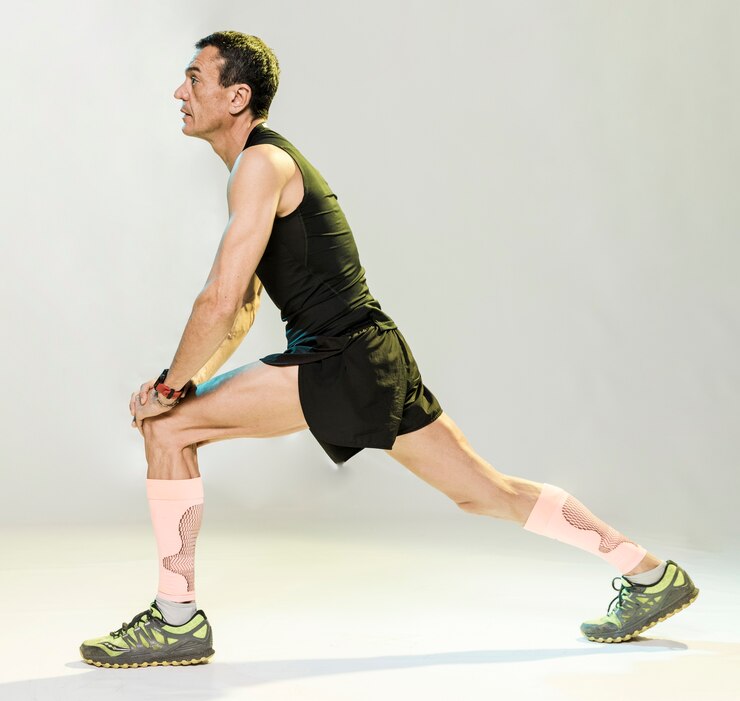
The knee is a highly complex joint designed to bend, extend, and support your body’s weight during movement. Its range of motion is essential for balance, flexibility, and strength. However, when this range becomes restricted—due to injury, ageing, or medical conditions—it can significantly impact your ability to perform even the simplest activities. Reduced mobility can lead to discomfort, stiffness, and, in many cases, a loss of independence, affecting both your physical and emotional well-being.
WHAT DOES THIS BLOG OFFER YOU?
In this blog, we’ll take a closer look at the common causes of limited knee mobility and how these restrictions can disrupt your daily life. Most importantly, we’ll introduce you to the innovative and holistic treatments offered at Vishudh Kaya Pain Relief and Multispeciality Clinic. Through a combination of advanced therapies and personalized care, our team is dedicated to helping you restore your mobility, ease discomfort, and regain control of your life.
1. Osteoarthritis: Wear and Tear of the Knee Joint
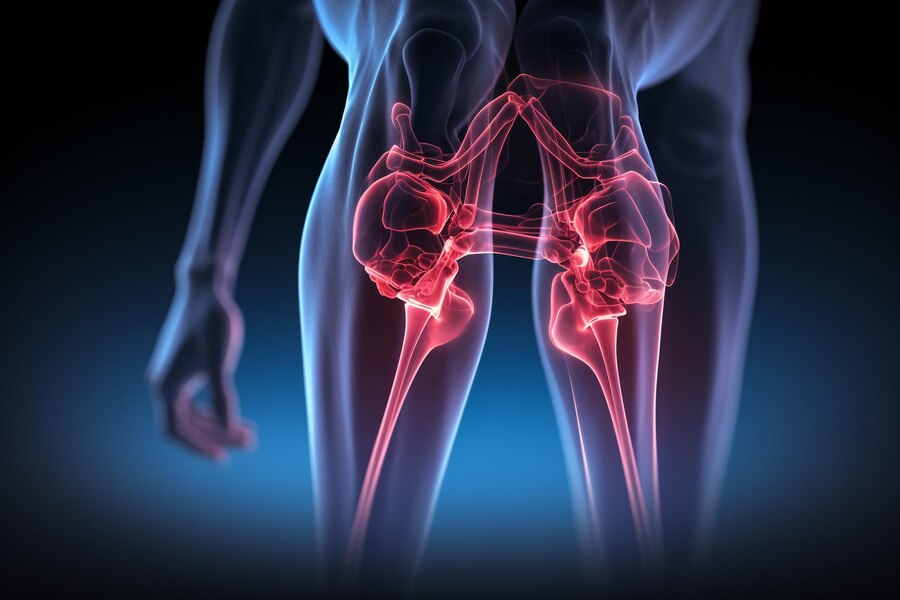
Osteoarthritis is a progressive condition that primarily affects the knee joint, causing the cartilage that cushions the joint to break down over time. Cartilage serves as a shock absorber, preventing bones from grinding against each other. As it deteriorates, the bones can begin to rub directly against one another, leading to inflammation, pain, and stiffness. This process of wear and tear can happen gradually, often starting with mild discomfort but progressing to more severe pain and immobility if left untreated. The loss of cartilage in osteoarthritis results in not only pain but also reduced functionality of the knee joint, making simple tasks, like walking, climbing stairs, or getting in and out of a car, increasingly difficult.
The cause of osteoarthritis is typically a combination of genetic factors, age-related wear, overuse, or injury. For instance, someone who has had a knee injury or surgery in the past may be more susceptible to developing osteoarthritis in the affected knee later in life. Overuse, especially in individuals who engage in repetitive high-impact activities, also accelerates cartilage breakdown. Additionally, age is a significant factor, as the cartilage naturally loses its ability to repair itself with time.
Symptoms -Osteoarthritis symptoms can vary in severity, with early signs often being mistaken for general wear and tear. However, there are some key indicators to look out for that can suggest osteoarthritis is affecting your knee joint:
✔ Pain: A deep, aching pain that worsens with activity and improves with rest is a hallmark symptom of osteoarthritis. The pain may become more persistent as the condition progresses.
✔ Swelling: Inflammation in the knee joint can lead to visible swelling, which can contribute to a feeling of tightness or stiffness.
✔ Stiffness: The affected knee may feel stiff, particularly after periods of rest, making it hard to fully bend or straighten your leg.
✔ Reduced Range of Motion: You may notice that your knee doesn’t move as freely as it once did, making it difficult to perform everyday tasks.
✔ Grating Sensation or Popping Sounds: As the cartilage wears down, bones may rub together, causing a grating sensation or a popping sound when you move your knee.
✔ Weakness or Instability: In more advanced cases, you might experience the sensation that your knee is unstable or “giving out” while walking or standing.
Struggling with knee pain from osteoarthritis? Vishudh Kaya offers effective treatments that can slow progression and improve mobility.
2. Meniscus Tear: A Common Knee Injury
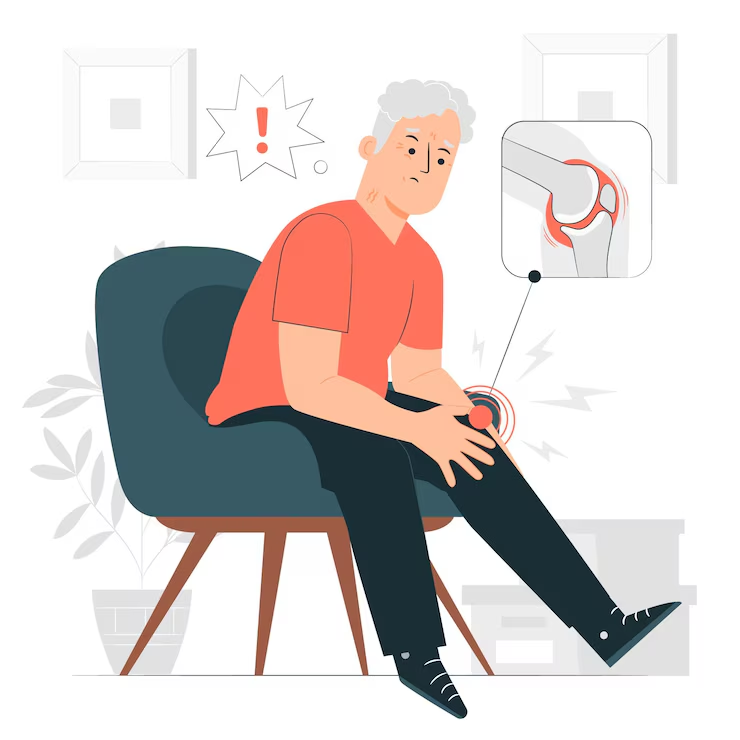
Is a Torn Meniscus Causing Your Knee Stiffness and Pain?
A meniscus tear is a common knee injury, typically resulting from twisting or pivoting motions during sports or physical exertion. The meniscus acts as a cushion between the bones of the knee, but when torn, it leads to pain, swelling, and limited mobility.
❖ Causes and Symptoms of a Meniscus Tear:
Meniscus tears can happen during activities that stress the knee, like sports or repetitive movements, especially in older individuals. Symptoms include:
✔ Pain around the knee, especially with twisting movements
✔ Swelling and tightness in the knee
✔ Stiffness and difficulty moving the knee fully
✔ Popping or clicking sounds when the knee moves
✔ Instability, making the knee feel like it might buckle
❖ How a Torn Meniscus Leads to Pain and Stiffness:
The torn meniscus causes pain due to friction between the bones, and swelling builds up, adding pressure and restricting movement. The torn cartilage may also get caught, causing the knee to lock or feel unstable. If untreated, the tear can result in long-term joint issues.
If you’re suffering from a meniscus tear, Vishudh Kaya’s holistic therapies can help speed up recovery and restore movement.
3. Ligament Injuries: ACL, MCL, AND MORE
❖ Injured Your Knee Ligaments? Here’s How It Affects Your Movement
Knee ligament injuries, such as those to the ACL (anterior cruciate ligament) or MCL (medial collateral ligament), are common in sports or intense physical activity. These ligaments are crucial for knee stability, and when injured, they can cause pain, and swelling, and significantly limit your ability to move the knee properly.
❖ How ACL, MCL, and Other Ligament Injuries Restrict Knee Movement:
Injuries to the knee ligaments can make it difficult to move your knee normally. A torn ACL, which often results from sudden twisting or pivoting, can prevent you from bending or straightening your knee fully. An MCL injury, usually caused by a blow to the outer knee, can also affect your ability to extend your knee completely. Any ligament injury disrupts the knee’s normal movement, making tasks like walking or climbing stairs more difficult and painful.
❖ How These Injuries Affect Knee Stability and Flexibility:
Ligament injuries reduce the knee’s stability, making it prone to giving way, especially when you’re active. You may feel like your knee is unstable or locked in place. Flexibility is also impacted, as the knee becomes stiff, restricting its ability to bend or straighten fully. If left untreated, these injuries can lead to ongoing instability and an increased risk of further damage to the knee joint.
Vishudh Kaya’s customized rehabilitation programs are designed to heal ligament injuries and bring back knee function.
4. Patellar Tendonitis: Inflammation in the Knee Tendons
❖ Pain Below the Knee Cap? It Could Be Patellar Tendonitis.
Patellar tendonitis, or “jumper’s knee,” is an inflammation of the tendon that connects your kneecap (patella) to the shinbone, usually caused by overuse or repetitive stress. This condition results in pain and discomfort, making it harder to move the knee smoothly.
❖ How Inflammation in the Patellar Tendon Affects Movement:
The patellar tendon is crucial for leg extension and shock absorption during activities like running and jumping. When it becomes inflamed, you may experience pain at the front of the knee, particularly when trying to bend or straighten the leg. This pain typically worsens with physical activity, reducing knee flexibility and making movements like squatting, running, or climbing stairs difficult.
❖ Causes and Treatments for Tendonitis:
Patellar tendonitis is often caused by repetitive movements like running, jumping, or cycling, particularly in athletes. Other factors, such as improper technique, weak muscles, or tightness in the hamstrings, can contribute to the condition.
Treatment generally includes rest, ice, and anti-inflammatory medications to ease swelling. Physical therapy is commonly recommended to strengthen the muscles around the knee and improve flexibility. In severe cases, corticosteroid injections or surgery may be necessary to help heal the tendon and relieve pain.
If patellar tendonitis is limiting your knee movement, Vishudh Kaya can help you regain your full range of motion through targeted treatments.
5. Bursitis: Inflammation of Knee Bursae
❖ Painful Swelling Around Your Knee? Bursitis Could Be the Cause.
Bursitis is the inflammation of the bursae, the small fluid-filled sacs in the knee that help reduce friction between tendons and bones. When these sacs become irritated, often from repetitive motion or pressure, it leads to swelling and pain that can restrict knee movement.
❖ How Bursitis Affects Knee Movement:
When the bursae are inflamed, swelling occurs around the knee joint, causing stiffness and limiting its range of motion. The pain typically intensifies with activity, making movements like walking, bending, or kneeling difficult and uncomfortable.
❖ Symptoms and Risk Factors:
Common symptoms of bursitis include pain, swelling, and tenderness around the knee, especially when pressure is applied. The knee may also feel warm to the touch.
Risk factors for bursitis include:
● Overuse: Repetitive activities like kneeling, running, or jumping put stress on the knee.
● Injury: A blow to the knee can trigger bursitis.
● Age: Older individuals are more likely to experience bursitis due to decreased flexibility of the bursae.
● Pre-existing conditions: Conditions such as arthritis can increase the likelihood of developing bursitis.
At Vishudh Kaya, we treat bursitis effectively with a combination of therapies that reduce inflammation and restore movement.
6. Knee Stiffness After Surgery
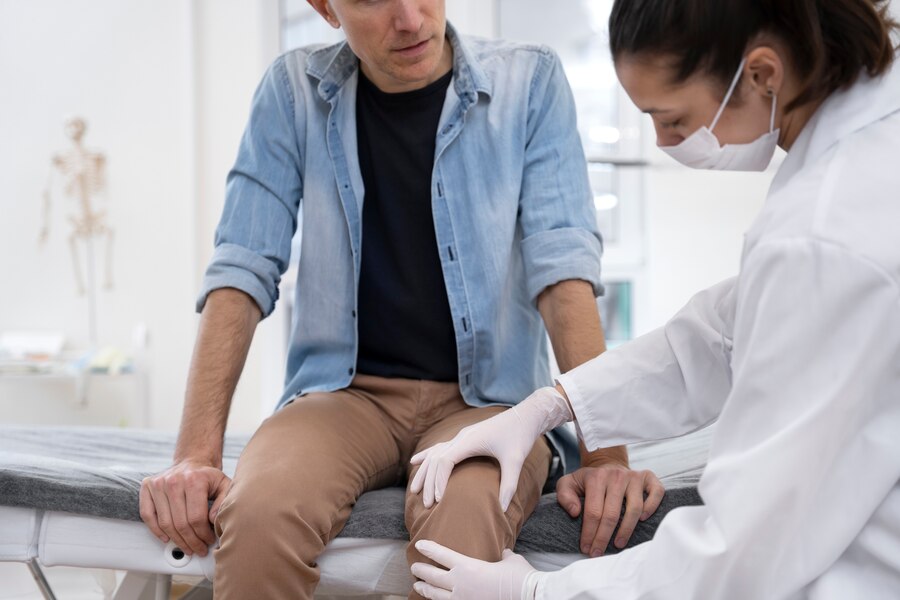
❖Recovering from Knee Surgery? Here’s Why You Might Experience Stiffness.
Knee stiffness is a common concern for individuals recovering from surgeries like knee replacement or ACL repair. The knee may feel tight or difficult to move, which can slow down recovery. Understanding the causes of this stiffness and how to address it can help improve the healing process.
❖ What Causes Stiffness After Knee Surgery?
Post-surgery stiffness is typically the result of factors such as inflammation, scarring, and muscle weakness. After a knee replacement, the new joint may take time to adjust, leading to temporary stiffness. In ACL surgery, the healing of tendons and tissues around the knee can also cause tightness. Additionally, muscles and ligaments need time to rebuild flexibility and strength, which can contribute to restricted movement.
❖ The Role of Physical Therapy in Recovery:
Physical therapy is an essential part of knee surgery recovery. It helps restore range of motion, reduce swelling, and strengthen the muscles around the knee. Through specialized exercises, physical therapy improves flexibility and reduces stiffness, allowing for a quicker return to normal knee function. Without proper physical therapy, stiffness can linger, slowing down recovery and limiting movement.
If you’re struggling with post-surgery stiffness, Vishudh Kaya can help you regain full knee mobility with expert rehabilitation.
7. Inflammatory Conditions: Rheumatoid Arthritis & Gout
❖ Inflammation from Rheumatoid Arthritis or Gout Could Be Holding You Back.
a. Rheumatoid Arthritis: In RA, the immune system mistakenly attacks the joints, causing inflammation in the knee. Over time, this leads to damage to cartilage, ligaments, and bones, resulting in pain, swelling, and limited knee movement.
b. Gout: Gout occurs when uric acid builds up in the bloodstream, forming crystals in the knee joint. These crystals cause sudden, intense pain and swelling, restricting knee movement.
● Signs of Inflammatory Arthritis in the Knee:
▪ Pain: Continuous, sharp pain that increases with movement or pressure.
▪ Swelling: The knee may become swollen due to inflammation, particularly after activity or in the morning.
▪ Redness and Warmth: The skin around the knee may appear red and feel warm to the touch due to inflammation.
▪ Stiffness: Difficulty bending or straightening the knee, especially after resting.
▪ Reduced Range of Motion: The knee may feel stiff or “locked,” making movement painful or challenging.
▪ Fatigue: General tiredness or discomfort may accompany knee symptoms, further affecting overall mobility.
These conditions can significantly hinder knee function, making it essential to seek medical advice for a proper diagnosis and treatment, which may include medications, physical therapy, and lifestyle modifications.
Vishudh Kaya offers holistic treatments for inflammatory conditions to reduce swelling and restore knee function.
8. Knee Locking: When the Knee Becomes Stuck
❖ Ever Experienced Your Knee Locking Up? Here’s What It Means for Your Range of Motion.
Knee locking happens when the knee gets “stuck” and cannot fully bend or straighten, which can restrict movement and cause discomfort.
❖ What Causes Knee Locking?
✔ Meniscal Tears: A tear in the meniscus, the cartilage that cushions the knee, can cause fragments to get caught in the joint, resulting in locking.
✔ Loose Cartilage: Damaged cartilage may break off and become loose within the joint, causing the knee to lock when these pieces get stuck.
✔ Inflammation: Swelling from conditions like arthritis can cause the knee to feel stiff and locked due to joint inflammation.
✔ Ligament Injuries: Injuries to ligaments, such as an ACL tear, can cause instability in the knee, leading to a sensation of locking or giving way.
❖ When Should You Seek Medical Help for Knee Locking?
✔ Frequent or Persistent Locking: If your knee keeps locking or feels stuck for long periods, medical attention is needed.
✔ Pain and Swelling: Severe pain, swelling, or redness along with knee locking could indicate a more serious injury, such as a meniscal tear.
✔ Walking Difficulties: If locking makes it hard to walk or move the knee, it’s a sign that a doctor should evaluate it.
✔ Inability to Move the Knee: If your knee can’t straighten fully or remains locked for extended periods, it’s important to get checked by a healthcare provider.
Knee locking should not be ignored, as it can signal an underlying issue that requires proper treatment, including physical therapy, medication, or possibly surgery.
If your knee is locking, Vishudh Kaya’s treatments can help diagnose the issue and restore fluid movement.
9. Fluid Buildup: Effusion in the Knee Joint
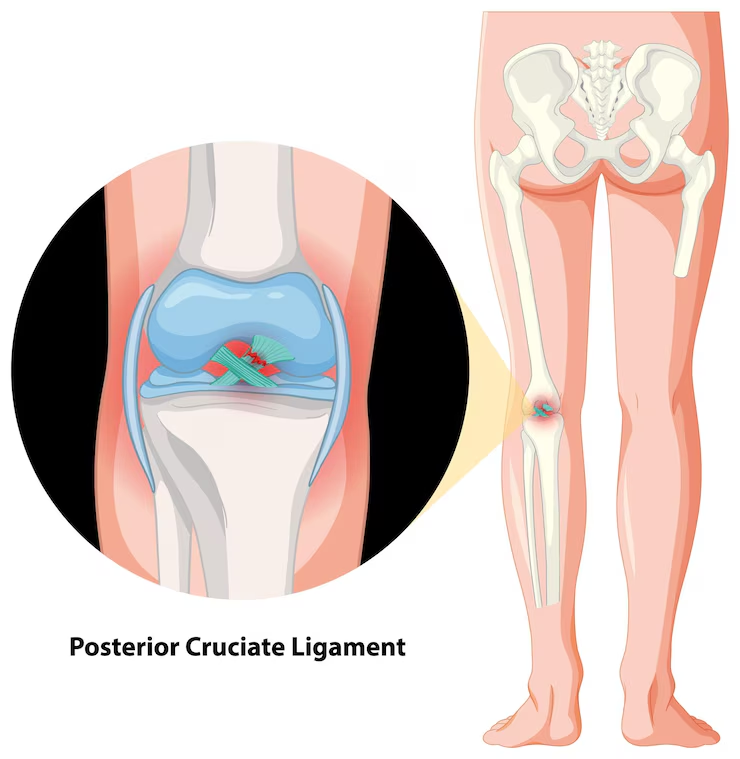
❖ Knee Swelling Affecting Your Mobility? It Could Be Fluid Buildup (Effusion).
Effusion occurs when excessive fluid gathers in the knee joint, leading to swelling, stiffness, and restricted movement, making even simple tasks like bending or walking challenging.
✔ How Fluid Buildup Reduces Flexibility:
Excess fluid increases pressure in the joint, causing discomfort and limiting mobility. This can make the knee feel stiff and tight, significantly reducing its range of motion.
✔ Causes of Knee Effusion and Its Impact on Movement:
▪ Injuries: Ligament tears, fractures, or meniscal damage often lead to inflammation and fluid accumulation in the knee.
▪ Arthritis: Osteoarthritis and rheumatoid arthritis trigger chronic inflammation, resulting in recurrent effusion.
▪ Infections: Septic arthritis, caused by bacterial infection, can cause significant swelling and fluid buildup.
▪ Gout and Pseudogout: Crystals forming in the joint due to these conditions lead to inflammation and fluid collection.
▪ Overuse or Strain: Excessive or repetitive knee movement can irritate the joint, causing fluid to accumulate.
Vishudh Kaya’s therapies focus on reducing fluid buildup and improving your knee’s range of motion.
10. Tight Muscles and Soft Tissues Around the Knee
❖ Could Tight Muscles Be Restricting Your Knee Movement?
Tightness in muscles, particularly in the hamstrings and quadriceps, can limit your knee’s range of motion, causing stiffness and discomfort that affects movement.
❖ Impact of Muscle Tightness on Knee Mobility:
✔ Hamstrings: When the hamstrings are tight, they can restrict knee extension, making it difficult to fully straighten the leg and limiting movement.
✔ Quadriceps: Tight quadriceps can increase tension in the knee, reducing its flexibility and causing stiffness.
✔ Other Soft Tissues: Tension in other areas, like the iliotibial (IT) band or calf muscles, can further restrict knee motion.
❖ Stretching and Strengthening Techniques for Improved Flexibility:
✔ Stretching: Regularly stretch the hamstrings and quadriceps to reduce tightness and enhance knee movement.
✔ Dynamic Movements: Incorporate exercises like lunges or leg swings to boost flexibility and prepare muscles for activity.
✔ Strength Training: Strengthen key muscles around the knee, such as the hamstrings and quadriceps, using exercises like squats, lunges, and bridges to improve knee stability.
✔ Foam Rolling: Use foam rolling to target tight spots in muscles like the quads, hamstrings, or IT band to release tension and improve flexibility.
These strategies can help alleviate stiffness, improve flexibility, and enhance overall knee movement. If tightness persists, consulting a physical therapist may be beneficial for personalized guidance.
Vishudh Kaya offers specialized programs to release muscle tension and improve your knee’s range of motion.
Conclusion
Limited knee movement can stem from several factors, including joint injuries, arthritis, tendon or ligament damage, muscle imbalances, or inflammation linked to underlying conditions. It can also result from overuse, ageing, or poor posture, which contribute to stiffness and restricted movement.
There are various treatment options available for restoring knee mobility. Approaches such as physical therapy, chiropractic care, osteopathy, and other techniques can significantly improve flexibility. Additionally, holistic treatments like homoeopathy and Ayurveda offer valuable long-term relief. Seeking professional care based on the specific cause can help regain mobility and enhance overall well-being.
Start Your Healing Journey Today
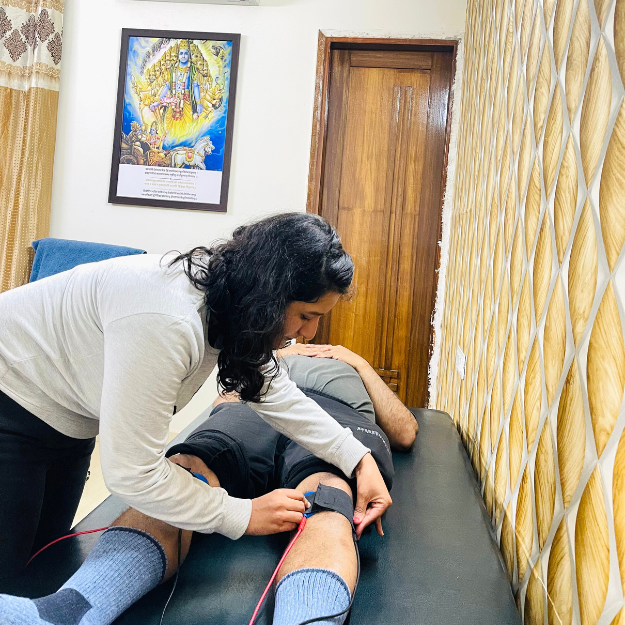
Don’t let knee pain limit your life. Visit Vishudh Kaya today for a personalized treatment plan that helps restore your knee’s full range of motion and get you back on your feet!

